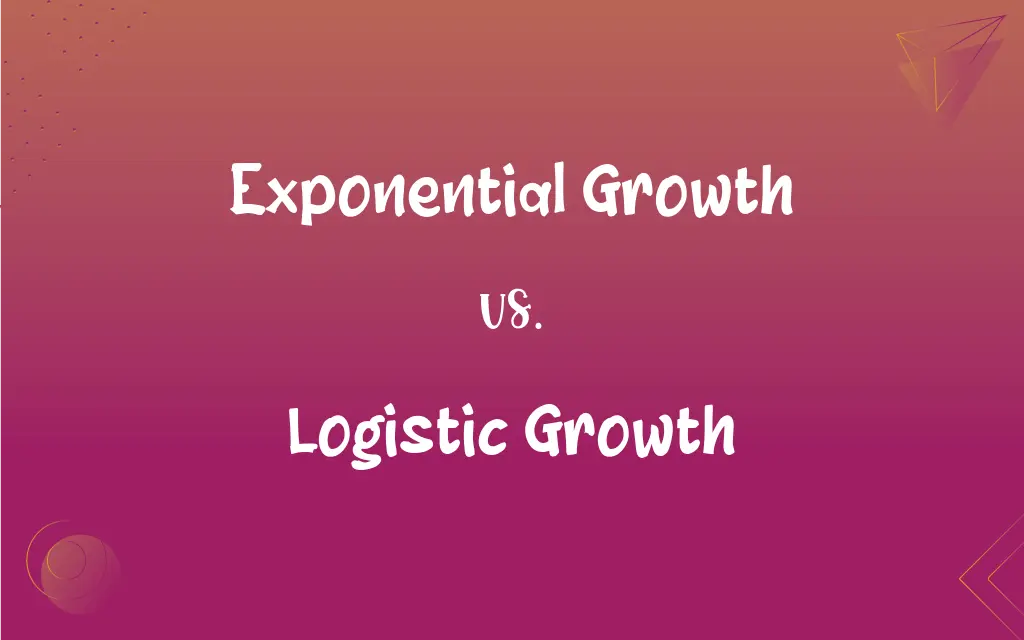Exponential Growth vs. Logistic Growth: What's the Difference?
Edited by Janet White || By Harlon Moss || Published on March 23, 2024
Exponential growth describes unchecked, rapid increase, whereas logistic growth includes a growth limit, starting fast but slowing as it approaches a maximum capacity.

Key Differences
Exponential growth occurs when a quantity increases at a rate proportional to its current value, leading to rapid expansion, unlike logistic growth, which incorporates environmental limits.
In exponential growth, resources are assumed to be unlimited, resulting in a continuous and steep increase. Logistic growth, conversely, considers resource limitations, leading to a plateau in growth.
Exponential growth is characterized by a constant doubling time, whereas logistic growth initially resembles exponential but slows down as it nears carrying capacity.
Logistic growth is more realistic for populations in natural ecosystems due to resource constraints, unlike exponential growth, which is idealized and less common in nature.
Exponential growth is often seen in unrestricted environments, whereas logistic growth models are applied in scenarios where environmental resistance impacts growth.
ADVERTISEMENT
Comparison Chart
Rate of Increase
Constant and rapid
Rapid initially, then slows down
Resource Assumption
Unlimited resources
Limited resources
Growth Pattern
Continuous increase
Increase followed by stabilization
Realism in Natural Systems
Less common, idealized
More realistic, considering constraints
Representation in Models
J-shaped curve
S-shaped curve
ADVERTISEMENT
Exponential Growth and Logistic Growth Definitions
Exponential Growth
Exponential growth doubles quantities in regular intervals.
A viral social media post can show exponential growth in views.
Logistic Growth
Logistic growth is more common in natural ecosystems.
Forest growth often follows a logistic pattern due to competition for light.
Exponential Growth
Exponential growth is a process of increasing in quantity at a constant rate.
Bacteria in a culture exhibit exponential growth in early stages.
Logistic Growth
Logistic growth describes growth that slows as it approaches a limit.
A wildlife population reaches logistic growth due to habitat limits.
Exponential Growth
Exponential growth is often unsustainable in natural settings.
Algal blooms in nutrient-rich waters demonstrate exponential growth.
Logistic Growth
Logistic growth considers the carrying capacity of the environment.
Fish populations in a lake grow logistically based on food availability.
Exponential Growth
Exponential growth is represented by a J-shaped curve.
Population growth in an unconstrained environment shows an exponential pattern.
Logistic Growth
Logistic growth starts rapidly but stabilizes over time.
Plant growth in a garden shows logistic growth as space becomes limited.
Exponential Growth
Exponential growth occurs without environmental constraints.
In ideal conditions, investment returns can follow exponential growth.
Logistic Growth
Logistic growth is represented by an S-shaped curve.
The spread of a controlled disease often follows a logistic growth model.
FAQs
What is exponential growth?
Rapid increase of a quantity at a constant rate.
What is a real-world example of logistic growth?
Population growth limited by food and habitat availability.
Where is exponential growth commonly observed?
In idealized or human-made systems with ample resources.
How is logistic growth defined?
Growth that accelerates initially but slows as it nears a limit.
What is the graph shape for logistic growth?
An S-shaped curve.
Does logistic growth always reach the carrying capacity?
Often, but not always, depending on environmental changes.
What shape represents exponential growth on a graph?
A J-shaped curve.
Is exponential growth sustainable in nature?
Rarely, as natural systems have limits.
How does resource availability affect exponential growth?
Exponential growth assumes unlimited resources.
Why does logistic growth slow down?
Due to environmental constraints and carrying capacity.
How does competition affect logistic growth?
It's a key factor in slowing growth as resources become limited.
Is logistic growth more predictable than exponential?
Generally, due to its consideration of limits and constraints.
What impact does human intervention have on exponential growth?
It can extend or limit growth, depending on resource management.
Are epidemics an example of logistic growth?
Yes, as disease spread often slows with immunity and intervention.
Can exponential growth be controlled?
Yes, through resource management and environmental interventions.
Can logistic growth occur in controlled environments?
Yes, especially in managed ecosystems like agriculture or aquaculture.
Can logistic growth be applied to economic models?
Yes, particularly when considering market saturation.
What factors can cause exponential growth to cease?
Resource depletion or environmental changes.
Is exponential growth common in technology adoption?
Initially, but it often shifts to logistic as markets saturate.
Can human populations exhibit exponential growth?
Temporarily, but it typically transitions to logistic growth.
About Author
Written by
Harlon MossHarlon is a seasoned quality moderator and accomplished content writer for Difference Wiki. An alumnus of the prestigious University of California, he earned his degree in Computer Science. Leveraging his academic background, Harlon brings a meticulous and informed perspective to his work, ensuring content accuracy and excellence.
Edited by
Janet WhiteJanet White has been an esteemed writer and blogger for Difference Wiki. Holding a Master's degree in Science and Medical Journalism from the prestigious Boston University, she has consistently demonstrated her expertise and passion for her field. When she's not immersed in her work, Janet relishes her time exercising, delving into a good book, and cherishing moments with friends and family.
































































